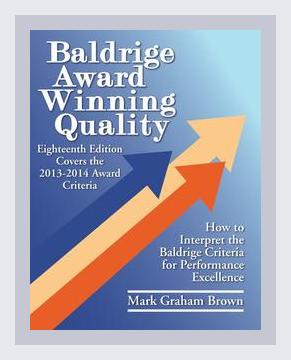Operations and Supply Chain ManagementQuality Control
Introduction:
“Baldrige Award Winning Quality” by Mark Graham Brown offers an in-depth look into the principles, strategies, and specific practices that businesses can adopt to achieve high standards of quality. The book is structured to provide actionable insights that organizations can use to improve their processes, products, and overall performance by leveraging the criteria established by the Malcolm Baldrige National Quality Award (MBNQA).
1. The Baldrige Framework: Overview and Importance
– Major Point: The book starts with an introduction to the Baldrige Framework, emphasizing its importance in fostering organizational excellence through a systematic approach focused on key business criteria.
– Actionable Insight: Organizations should get acquainted with the seven categories of the Baldrige criteria: Leadership, Strategy, Customers, Measurement, Analysis, and Knowledge Management, Workforce, Operations, and Results.
– Example: Recognizing the role of strong leadership, businesses like Ritz-Carlton have incorporated Baldrige principles to cultivate a service-oriented culture that has led to sustained customer satisfaction.
2. Leadership
– Major Point: Leadership is fundamental to setting the tone for quality and establishing organizational vision and values.
– Actionable Insight: Senior leaders should engage with employees at all levels, actively communicate the organization’s vision and values, and create a culture of continuous improvement.
– Example: The book highlights how former Baldrige winners like Motorola implemented regular “skip-level” meetings, where senior managers engage directly with front-line employees to gain insights and foster a culture of open communication.
3. Strategic Planning
– Major Point: Effective strategic planning aligns an organization’s processes with its mission, vision, and goals.
– Actionable Insight: Develop a comprehensive strategic plan that defines long-term objectives and includes performance projections and action plans to reach these goals.
– Example: The book details how IBM Rochester used the Baldrige framework to refine their strategy-planning process, resulting in innovative product offerings that aligned with market needs and technological advancements.
4. Customer Focus
– Major Point: A strong focus on customers ensures that organizations can meet and exceed customer expectations, which is critical for long-term success.
– Actionable Insight: Implement robust methods for capturing customer feedback, analyzing customer needs, and integrating this feedback into product and service development.
– Example: The book cites FedEx, which utilized comprehensive customer satisfaction surveys and focus groups to continuously improve their service delivery and responsiveness.
5. Measurement, Analysis, and Improvement of Organizational Performance
– Major Point: Measurement and data analysis are crucial for making informed decisions and driving continuous improvement across the organization.
– Actionable Insight: Develop a performance measurement system that includes key performance indicators (KPIs) aligned with strategic objectives and conduct regular performance reviews.
– Example: Hewlett-Packard (HP) created a “balanced scorecard” approach to track progress on multiple fronts, including financial performance, customer satisfaction, internal processes, and innovation.
6. Workforce Focus
– Major Point: The workforce is a key asset, and nurturing talent is essential for achieving high-quality results.
– Actionable Insight: Invest in employee development programs, establish a recognition and reward system, and promote work-life balance to enhance employee engagement and productivity.
– Example: The book discusses Ritz-Carlton’s dedication to continuous training and employee empowerment, which has been instrumental in maintaining high levels of customer service.
7. Operations Focus
– Major Point: Efficient and effective operations are critical for maintaining quality and achieving operational excellence.
– Actionable Insight: Streamline processes using methodologies such as Lean, Six Sigma, and Total Quality Management (TQM) to eliminate waste and improve process efficiency.
– Example: The book showcases how Sunny Fresh Foods implemented Six Sigma to reduce process variation and eliminate defects, leading to significant cost savings and improved product quality.
8. Results: Performance Outcomes
– Major Point: The ultimate measurement of quality initiatives is reflected in performance outcomes across various dimensions such as customer satisfaction, financial performance, and operational efficiency.
– Actionable Insight: Track and communicate result metrics internally and externally, using them as a basis for further improvement and strategic adjustments.
– Example: The book illustrates how the North Mississippi Health Services’ use of rigorous performance measurement and feedback loops helped the organization achieve superior patient care and operational performance.
9. Integration and Alignment
– Major Point: Effective integration and alignment of processes and strategies across the organization are paramount for achieving synergy and consistency.
– Actionable Insight: Ensure alignment between strategic objectives and day-to-day operations, integrating quality management into the overall business model.
– Example: Boeing’s implementation of the Baldrige criteria helped them align their diverse business units toward a unified goal of operational excellence and product innovation.
10. Innovation and Continuous Improvement
– Major Point: Continuous innovation is essential for sustaining competitive advantage and adapting to changing markets.
– Actionable Insight: Foster a culture that encourages experimentation, adopts new technologies, and continuously seeks improvements.
– Example: The book mentions how Procter & Gamble championed an “open innovation” model, partnering with external innovators to maintain a pipeline of breakthrough products.
11. Learning from Best Practices
– Major Point: Learning from best practices of Baldrige winners offers valuable insights that can be adapted to other organizations.
– Actionable Insight: Conduct benchmarking studies, observe leading practices, and tailor these insights to fit your organization’s unique context.
– Example: The book provides an instance of how Texas Nameplate Company benchmarked against top performers to refine their processes, leading to improved efficiency and employee morale.
Conclusion:
The lessons and examples detailed in “Baldrige Award Winning Quality” epitomize the holistic approach required to achieve and sustain high quality within an organization. By carefully understanding and applying the Baldrige criteria, businesses can enhance their competitive edge, cultivate a culture of excellence, and achieve remarkable results across various performance dimensions.
